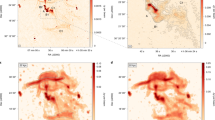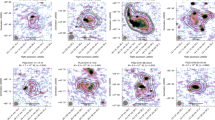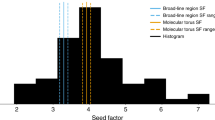Abstract
RECENT discussions about the source of energy in strong extra-galactic radio sources have indicated the possible importance of the nuclei of galaxies. In the nuclei the densities are large, and thus the energies available in principle are large, too. The matter in these nuclei is probably largely stellar and the problem that arises is how the stars can yield the energy that is needed (up to 1060 ergs) in a sufficiently short time. Burbidge1 proposed that in dense nuclei the heat wave emanating from a supernova might trigger the supernova process in surrounding stars. It is not obvious that a brief heating of the surface of a star is really sufficient to initiate an explosion. Hoyle and Fowler2 and Burbidge, Burbidge, Fowler and Hoyle3 considered that very massive stars of up to 108 solar masses could yield the required energies. However, neither the formation nor the stability of such large objects has been made plausible; unless the opposite is demonstrated one should expect that rotation and fragmentation prevent the formation of these bodies. Burbidge et al. consider that during the final stages of such massive objects large amounts of energy may be supplied during a prolonged time. They suggest that after the implosion—which effectively places them beyond our event horizon—these objects may reappear and oscillate so to say into and out of our universe, all the time releasing energy. It should be stressed that this possibility exists only in a relativity theory that has been adopted to the requirements of continuous creation. In orthodox relativity no such possibility arises. In a sense it is not surprising that with continuous creation a large amount of energy can be produced !
This is a preview of subscription content, access via your institution
Access options
Subscribe to this journal
Receive 51 print issues and online access
$199.00 per year
only $3.90 per issue
Buy this article
- Purchase on Springer Link
- Instant access to full article PDF
Prices may be subject to local taxes which are calculated during checkout
Similar content being viewed by others
References
Burbidge, G. R., Nature, 190, 1053 (1962).
Hoyle, F., and Fowler, W. A., Mon. Not. Roy. Astro. Soc., 125, 169 (1963).
Burbidge, E. M., Burbidge, G. R., Fowler, W. A., and Hoyle, F. (to be published).
Woltjer, L., Astrophys. J., 130, 38 (1959).
Smith, S., Astrophys. J., 82, 192 (1935).
Colgate, S. A., and Johnson, M. H., Phys. Rev. Letters, 5, 235 (1960).
Sweet, P. A., Mon. Not. Roy. Astro. Soc., 125, 285 (1963).
Author information
Authors and Affiliations
Rights and permissions
About this article
Cite this article
WOLTJER, L. A Source of Energy for Radio Galaxies. Nature 201, 803–804 (1964). https://doi.org/10.1038/201803a0
Issue Date:
DOI: https://doi.org/10.1038/201803a0
This article is cited by
-
Aktive galaxien
Die Naturwissenschaften (1975)
-
Evolution of dense galactic nuclei through dwarf star collisions
Nature (1974)
-
Stellar collisions
Il Nuovo Cimento B Series 10 (1967)
-
Production of Mesons in the Nuclei of Galaxies
Nature (1966)
-
Quasistellare Radioquellen ? Dichtekrisen im Kosmos
Die Naturwissenschaften (1964)
Comments
By submitting a comment you agree to abide by our Terms and Community Guidelines. If you find something abusive or that does not comply with our terms or guidelines please flag it as inappropriate.



